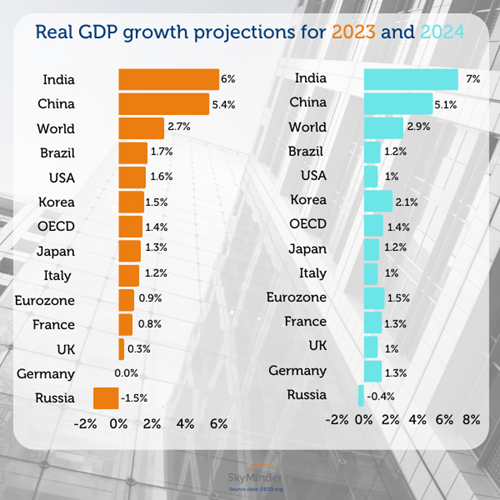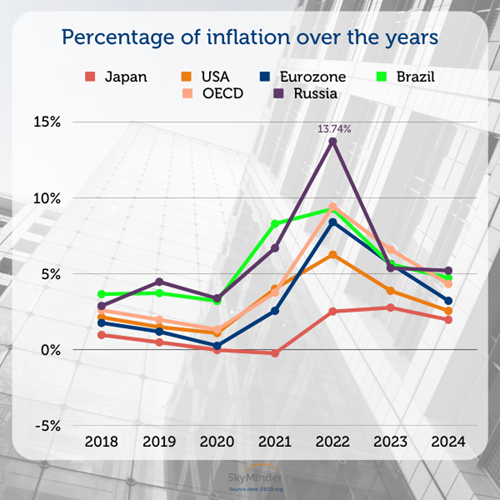Analysis and Studies - Studies
OECD Economic Outlook of June 2023: an inisght
June 30th 2023
The OECD (Organization for Economic Co-operation and Development) is an international organization that promotes economic growth, prosperity, and sustainable development among its member countries. It was established in 1961 and currently consists of 38 members, primarily from Europe, North and South America, and the Asia-Pacific region.
The OECD provides a platform for member countries to discuss and collaborate on economic policy issues, share best practices, and develop policies that promote economic and social well-being. It serves as a forum for governments to address global challenges, exchange information, and coordinate their efforts to tackle common issues.
According to the new report published by the Organization for Economic Co-operation and Development (OECD), the global economy is displaying some positive signs of recovery, although the progress is still relatively weak and faces significant risks. One favorable factor is the decrease in energy prices, which has contributed to reducing overall inflation and alleviating financial pressure on households. Additionally, the earlier reopening of China than expected has given a boost to global economic activity. However, there is a persistent issue with core inflation, which remains at elevated levels. Furthermore, the impact of higher interest rates is increasingly being felt across various sectors of the economy.
 Projections indicate that global GDP growth in 2023 is expected to be 2.7%, marking the lowest annual rate since the global financial crisis, excluding the pandemic-hit year of 2020. A modest improvement to 2.9% is anticipated for 2024. The annual GDP growth of OECD countries is predicted to be below the trend in both 2023 and 2024. However, as inflation moderates and real incomes strengthen, there is a gradual expectation of a pickup in GDP growth throughout 2024. Among the growing countries according to GDP growth for 2023, there are the world’s major economies with India (6%), China (5.4%), Brazil (1.7%), USA (1.6%), Korea (1.5%), Japan (1.3%), Italy (1.2%), France (0.8%) the UK (0.3%), and Russia, which is the only country in the list showing a decrease in the total GDP growth with -1.5%, whereas Germany shows no growth. According to the estimates for 2024, the countries listed above show different GDP change compared to the previous year. Indeed, India and
Projections indicate that global GDP growth in 2023 is expected to be 2.7%, marking the lowest annual rate since the global financial crisis, excluding the pandemic-hit year of 2020. A modest improvement to 2.9% is anticipated for 2024. The annual GDP growth of OECD countries is predicted to be below the trend in both 2023 and 2024. However, as inflation moderates and real incomes strengthen, there is a gradual expectation of a pickup in GDP growth throughout 2024. Among the growing countries according to GDP growth for 2023, there are the world’s major economies with India (6%), China (5.4%), Brazil (1.7%), USA (1.6%), Korea (1.5%), Japan (1.3%), Italy (1.2%), France (0.8%) the UK (0.3%), and Russia, which is the only country in the list showing a decrease in the total GDP growth with -1.5%, whereas Germany shows no growth. According to the estimates for 2024, the countries listed above show different GDP change compared to the previous year. Indeed, India and  China are still leading the list with 7% and 5.1% of growth respectively. Russia is still closing the list with a decline in its GDP -0.4%, slightly better than the previous year. Other European countries, such as Germany, France, the UK, and Italy register contrasting growths. Indeed, while the previous year Italy registered a GDP growth of 1.2%, in 2023 the same grew only by 1%. Moreover, all the other European countries listed above registered a higher growth compared to its previous year.
China are still leading the list with 7% and 5.1% of growth respectively. Russia is still closing the list with a decline in its GDP -0.4%, slightly better than the previous year. Other European countries, such as Germany, France, the UK, and Italy register contrasting growths. Indeed, while the previous year Italy registered a GDP growth of 1.2%, in 2023 the same grew only by 1%. Moreover, all the other European countries listed above registered a higher growth compared to its previous year.
In recent months, headline inflation has declined in many economies due to the decrease in energy prices, despite the continued rise in prices for food and services. Nevertheless, core inflation remains persistently high, posing a challenge to overall price stability. Russia is the country experiencing the highest inflation rate in 2022, with 13.7%.
